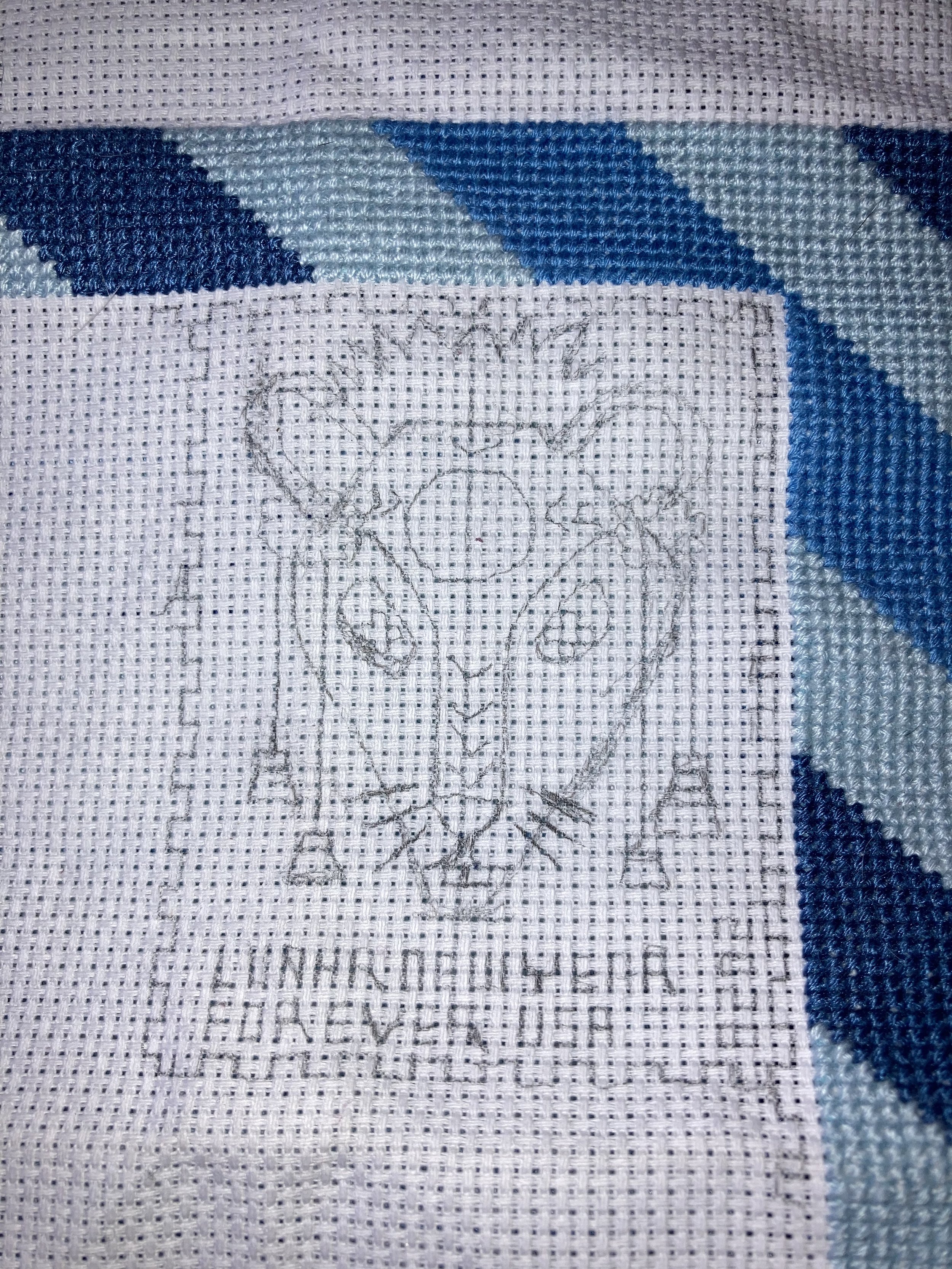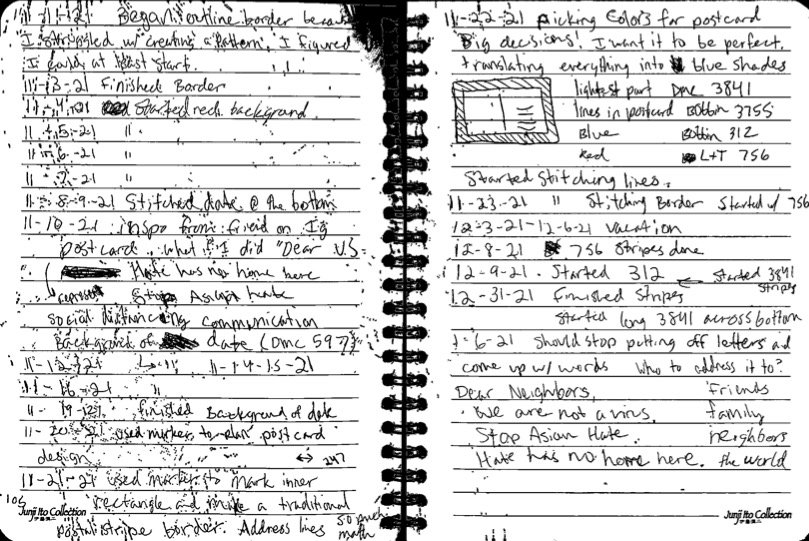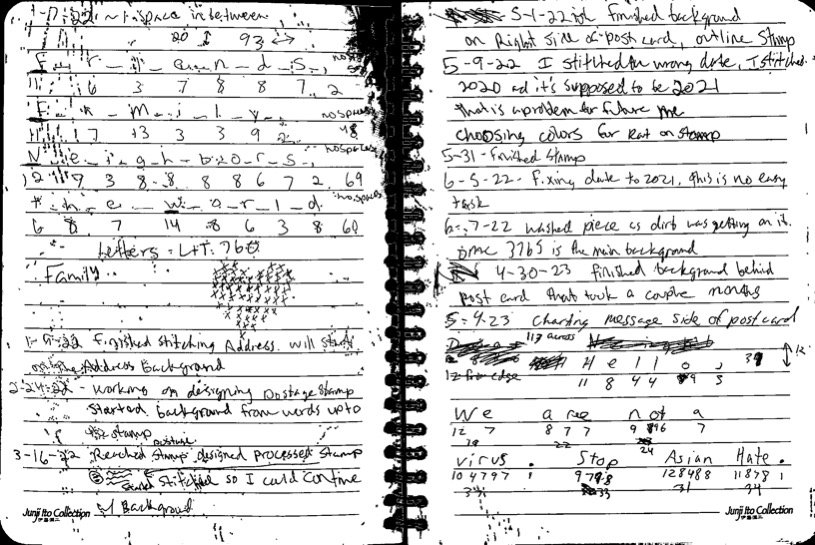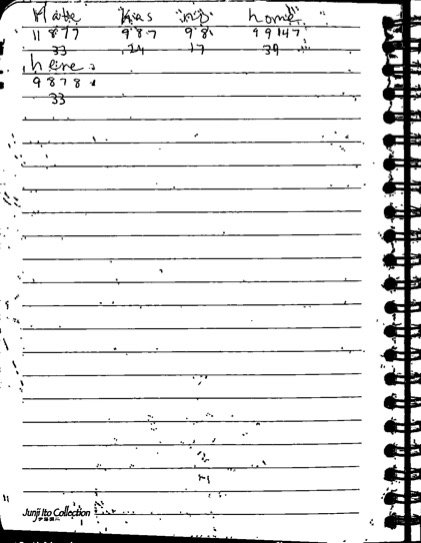4 de abril del 2021
Estadísticas:
Casos reportados: 79,878
Muertes reportados: 1,000
Tamaño del bloque: 22” x 22”
Bordado por: Lily Dawson
Ubicación: Ohio
How the Pandemic has affected me — essay by Lily Dawson
I was going through so many life changes in the months leading up to the day that the U.S. went into a lockdown due to Covid-19. I had just graduated with my Bachelor’s from Baylor University in Waco, Texas, in 2019. That fall, my fiancée (now husband) and I moved back to our home state of Illinois so I could attend the University of Illinois Urbana-Champaign. I went for my Masters in Library and Information Science. We got married in October and celebrated with our friends and families. Getting married during my first semester of grad school was a bit much, but looking back, I’m so glad we did.
It was the middle of my second semester when everything in-person shut down. The iSchool at UIUC was uniquely prepared as they offered their MS/LIS program, as well as others, online and in-person. However, it was particularly disheartening for myself and others who had moved there because we wanted an in-person experience. I was also doing a practicum at the local library that semester, so I missed out on a lot of first-hand experience. An anecdote from this, I’ll never forget the day before the library lockdown. There were lots of patrons checking out large stacks of books to keep them occupied.. At first, we thought it wouldn’t last too long since everyone would be in quarantine, but we soon learned that the lockdown and certain places would be closed for much longer.
I was working at a local used bookshop, Jane Addams Bookshop, which consisted of me and four other employees (including the owners). I only worked 10 hours a week because of school, but I loved that job so much. We were closed for 3-4 months, basically the end of spring and almost the entire summer. I am so grateful that I was able to keep my job and because of the federal unemployment policies put in place, I was able to collect that amount and my regular unemployment. We were able to stay afloat and put a lot into savings.
My husband was working for UPS and it took a toll on him physically and mentally. He started out working early mornings loading the trucks and took on driving during the busiest time, “peak season”, a.k.a. the holidays. He became a full time driver in April due to the pandemic. Everyone was ordering things online nonstop. It was like peak season for over a year, maybe longer. He would work 9-10 hour days, not know what route he would have, and have to lift heavy items, like mattresses and ping pong tables up however many flights of stairs by himself. The rule was a driver couldn’t go home until they completed all of the deliveries. They might get help, but that didn’t happen too often. Obviously, the job is physically demanding, but mentally it drained his soul. He was constantly tired and often didn’t have energy to do much. His anxiety heightened because he wasn’t sure what route he’d have that day and wouldn’t always know what the delivery preferences of each stop were. His job was and is considered essential. We were thankful to have that income, but after a year-ish, we reached a breaking point and he left.
We did our best to keep in touch with our family and friends via Zoom and FaceTime calls. The summer was mushy for me, in the sense that I didn’t have class or a daily structure so the days blend together. I filled the time with Animal Crossing, cross stitch, reading, watching YouTube, and taking our pets on walks. My sleep schedule was messed up for a long time. I would stay up until 3-4am and sleep until about 10am. Going to the grocery store was an event, an excuse to dress up.
Looking back on this part of my Covid-19 experience, I get a little emotional because I was so incredibly fortunate to be at UIUC, where they seemingly cared about the pandemic. (1) I don’t remember the exact date, but UIUC began administering its groundbreaking rapid saliva Covid-19 test. (2) I believe it was introduced in the summer of 2020 and became mandatory for all students and staff living in the area (even though we were completely online) to test at least 2 times a week. I’ll just summarize the process, but I will link articles that describe it more in depth. (3) There were around 17 collection sites all over campus. We swiped our ID, were given a plastic tube, and were told to fill it to a certain line. We would get our results within a few hours via email or through an app. If the test was positive, it was expedited and the person would be notified in 30 minutes. Because of all of the precautions the university was taking, I personally felt as safe as one could be. Frequent testing along with getting vaccinated, wearing masks, and isolating were helpful.
I went back to work in the fall of 2020 and classes resumed, but only online. I wasn’t mentally prepared to continue doing graduate school online. Again, we only thought it would be for that half semester. Despite loving the lectures and topics, it was difficult for me to concentrate. It felt like it took a monumental amount of energy to do any assignment that would have normally been fine. I had imposter syndrome and guilt because I had classmates who were working full time, had children, and other life obligations that seemed to manage well and I couldn’t gather the mental capacity to do a reading.
I finished earning my degree online and I got to do a small-scale virtual commencement. Finding a job fresh out of graduate school was incredibly difficult because it was a combination of the pandemic, hiring freezes, and an oversaturated job market. Over the summer, I applied to over 100 library jobs. At first, I was only looking at full-time positions, but got desperate enough for part-time (my husband had left his job). I got a handful of interviews that didn’t go anywhere, but eventually found a part-time job in Columbus, Ohio. I’ve been at this job ever since and became full time in spring of 2023.
My family is fortunate to not be majorly affected by Covid-19 other than lockdown and knowing people who caught it. Those who did get it, recovered. I didn’t live near my family, but they would keep me up-to-date. They took all the appropriate measures to protect themselves and my grandma. My husband and I did the same for ourselves and the ones around us. We both ended up contracting Covid-19 in the summer of 2022. We were fully vaccinated and still masking, but the Delta Variant was going around. I had never felt so sick before and I couldn’t imagine what it would have been like had we not been vaccinated. I had brain fog and intense cold-like symptoms. The weirdest symptoms were my ears feeling like they couldn’t pop and I had random hot flashes. For a few months after, I would be short-of-breath at the end of the day. I found myself having trouble breathing while talking, but it eventually went away.
For me, the pandemic affected my mental health the most. I am Chinese American and the rise in hate crimes against Asians felt very personal. My anxiety about a potential confrontation happening at work or the grocery store was at the forefront of my mind. I have been fortunate to not have such experiences other than an offhand comment from a relative.
Even before the pandemic I was concerned with politics and what was going on in the world, but my anxiety about it heightened significantly. The pandemic further exposed the major issues in the U.S., such as, but not limited to, access to healthcare and capitalism. I’m not an expert on these things by any means, but the constant and easy access to media has widened my perspective on a lot of things. These last few years, when people ask how I’m doing, I feel like my honest answer is something along the lines of “I’m here” or “I’m coasting.” It could be better, but it could also be worse. I would love to be at a point where myself and others are content and thriving, but considering the state of the U.S., I don’t know if that is possible. I know that sounds abysmal, so I try to be cautiously optimistic.
The pandemic was hard for a lot of us and for varying reasons. We’ll still be experiencing the aftermath of the pandemic for a long time and I don’t think we’ll ever be able to go back to the “before times.” I hope that projects like Stitching the Situation inspire people to document their experience of the pandemic. Sharing our stories helps grow empathy for one another, recognize essential workers, and remember those we have lost to the pandemic.
Process
My design is more catered towards cross country stitching rather than gridding. I liked to
pick a section to stitch in its entirety before moving to the next. For example, I did the dark blue stripes before moving to the lighter blue stripes.
When I began this project in November 2021, we had just moved to a new state because I had finally got a job after graduating graduate school. I was only working part-time (moving states for a part time job is definitely an indicator of how the job market is (still), but that is another story) so I had a lot of time to cross stitch. I would sometimes stitch for hours before I had to go to work. After living here a bit, I took on a second job and my cross stitching time decreased. Sometimes I would take days or weeks long breaks.
Design
Before this, I had never made my own pattern and I didn’t know where to start. I thought
about using a pattern generator to pixelate a photo, but I didn’t know what photo to use. It took me a while to come up with an idea. I knew I wanted the message to be about the rise in anti-Asian sentiment. I am Chinese American and the rise in hate crimes against Asians felt very personal. My anxiety about a potential confrontation happening at work or the grocery store was at the forefront of my mind. I have been fortunate to not have such experiences other than an offhand comment from a relative. The design unfolded as I went. I would stitch a section while thinking of the design of another.
I decided to use a postcard as a vehicle for this message. To me, a postcard is representative of one of the ways we stayed connected to one another during lockdown and social distancing. I went for a classic looking postcard with the USPS stripes. I kept the background a solid color and the date at the bottom.
The hardest part of the project was designing and stitching the stamp. The 2020 USPS Lunar New Year stamp was perfect because 2020 was the Year of the Rat. It holds so much meaning to me as I was born under this Zodiac animal and I was looking forward to this year being “my year.” I wanted to emulate this design as best as possible in the blue shades, so I utilized half and quarter stitches and backstitching to capture all of the details. I finally finished
this portion when I realized I had actually got the date wrong for a moment and thought my day was April 8, 2020, when it was actually in 2021. I was initially upset as I had done all that work, but I realized it can still stand as a symbol for the year everything went into lockdown and my signature. I also incorporated the number of stitches and date into the round postage stamp.
Who this message is for was easy because it’s personal yet broad. Coming up with the visual message was the final design element I had to come up with and it was challenging because I wanted to get it exactly right. I felt the best way to call out anti-Asian sentiment is to be simple and direct. We are not a virus. Stop Asian Hate.
There are a few quirks about the way it looks that I think make it even more unique than it already is. There’s a section of the postcard background (really light blue) that looks discolored and doesn’t match the majority. It could be because of the long breaks I took, I could’ve gotten slightly the wrong color, or it could be that DMC slightly altered the color and not the number over the course of this project. Who knows? Perhaps it could be a quiet reminder of how long it took for this square to come together. I washed the piece a couple times in an attempt to keep it clean of dirt, finger oils, and pet hair. There’s definitely pieces of cat hair embedded in the threads no matter how much I tried to wash them away. I think there are patches where the floss has frayed a little (I gave a slight trim) and stands out a little more than others since they were stitched so early in the process. Parts of the fabric were stuck in a snap frame for months. My husband bumped our coffee table and some drops of candle wax got on the piece. I tried blow drying to melt the wax and washing, but the spots are still there. I mention all of these little things so as not to complain or say that I don’t like it. I think they show the journey of making this square.








